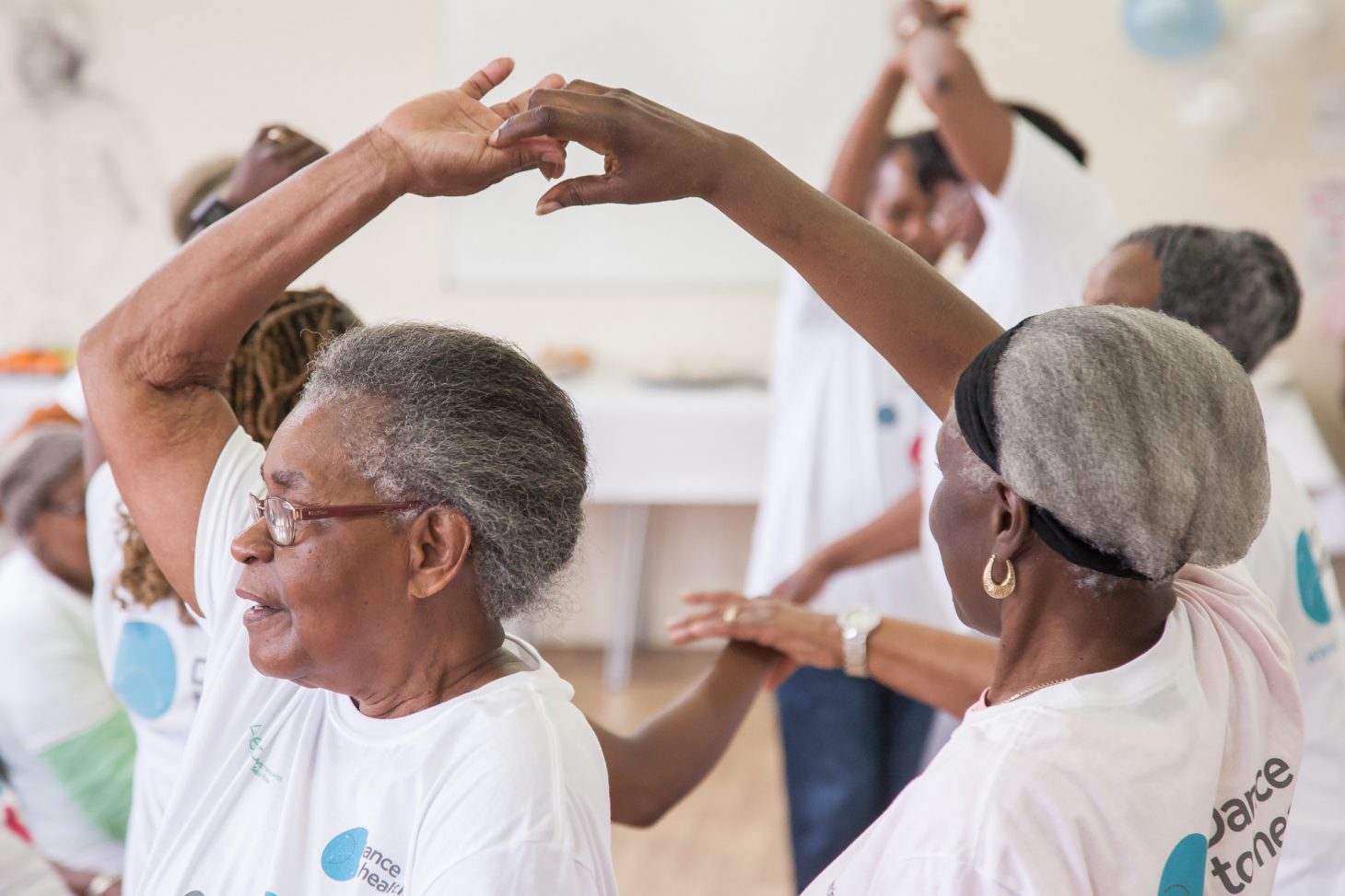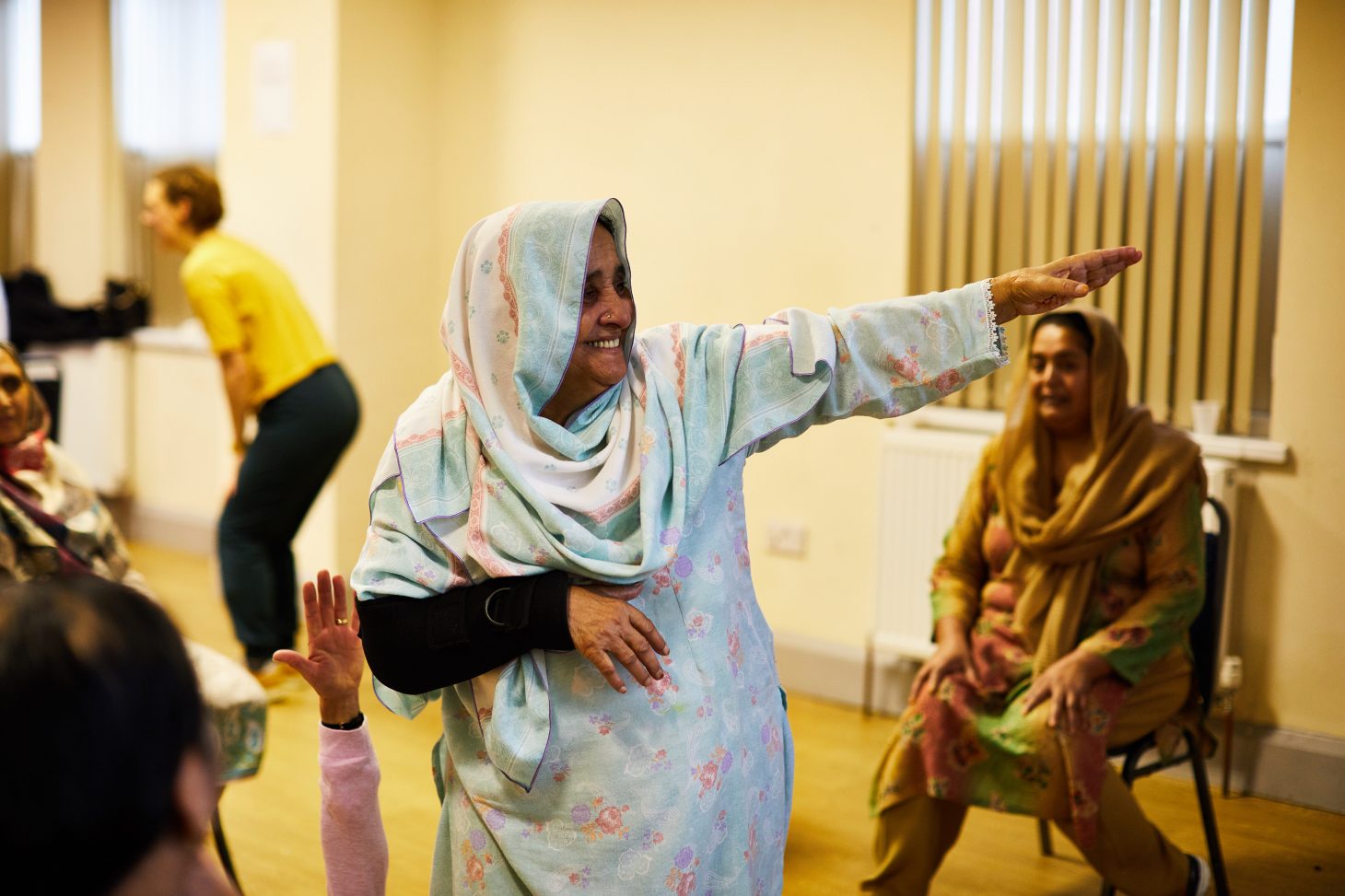A unique contribution to overcoming the Covid crisis from Tim Joss, Chief Executive & Founder of Aesop, the charity and social enterprise finding artistic solutions to society’s problems.

Photo Ranjan Jolly
It’s a DVD I treasure: a 2008 BBC film which follows Sadlers Wells’ Company of Elders, its over-60s non-professional dance group, creating with choreographer Chris Tudor and performing a new work to music by Hoagy Carmichael.
A special moment comes when Eve, tenderly holds a fellow dancer’s head in her hands. A gentle embrace follows. Back at home, she reflects. ‘A lot of us live on our own and we don’t get touched. It is wonderful that, particularly as you get to know the group and they get to know you, all self-consciousness fades. And you dance. You don’t think God there’s this man touching me and he’s right up against me. That doesn’t occur to you because it’s dance. So he’s not that man. He’s your partner for the dance.’
Covid has deprived many of us of this special power of touch. My organisation, Aesop, runs a dance programme for older people called Dance to Health. All our local groups from Swansea to Norfolk have had to stop live sessions. We’ve adapted, now offering online classes, tailored programmes for frailer older people, DVDs for areas with poor broadband, and coffee mornings to help solve participants’ digital problems.

Photo Brian Slater
Eventually Covid will be contained and dance activities will resume. Looking ahead, I see three major opportunities.
The first is better communication of dance’s power to the unconvinced. We’re not getting through. Arts subjects in schools continue to decline. A 2017 report by the All Party Parliamentary Group on Arts, Health and Wellbeing concluded ‘the UK is still very far from realising more than a small modicum of the potential contribution of the arts to health and wellbeing.’
Aesop has created the Active Ingredients Project. The medical/pharmaceutical metaphor is used to emphasise that there is something particular – some property, some dynamic – in the arts experience itself which enables certain artistic outcomes to occur, such as expression (finding a voice, making performances that are special, and telling stories) and achievement (a state of flow/absorption, accomplishment and celebration). Eve’s reflection highlights several important ‘active ingredients’: a safe space, trust, and actions for artistic expression like Eve’s which would be unacceptable in everyday life.
With a better artistic case for dance, we can move to the second opportunity: making common cause with the health sector to dramatically improve people’s health and the financial fortunes of the arts.
Dance to Health was created to address a particular challenge: older people’s falls. These cost the NHS £2.3 billion a year. They reduce confidence to do daily activities, lead to social isolation and loneliness, and threaten independence. The risk of falls increases with age, social deprivation and frailty. The NHS commissions well-evidenced falls prevention exercises but researchers have concluded the exercises are ‘dull’. Provision is patchy. Completion rates are low. And without maintenance programmes, improvements are lost in 12 months, yet these programmes are rare.
A £2.1 million development programme revealed Dance to Health’s potential. A Sheffield Hallam University evaluation concluded it ‘offers the health system an effective and cost-effective means to address the issue of older people’s falls‘, including a potential annual cost saving for the NHS of £79 million. The creative, sociable, fun activity ensures high adherence over the long term. While folk dance and ballroom do not reduce falls, Dance to Health does – by 58%. While drugs often have negative side-effects, Dance to Health has positive ones. Participants say they become more active (95%), have improved mental wellbeing (96%), make new friends (87%) and would recommend Dance to Health (98%). And crucially, dance artists enjoy the creative challenge of smuggling falls prevention exercises into their sessions.
Dance to Health shows a triple win is possible: more older people enjoying dance and its benefits, more employment for dance artists and saving the NHS money.

Photo David Lindsay
This leads to the final opportunity: financially sustainable dance programmes available for all who need them. It will take time. We will need a supply of trained dance artists spread across the country, but until then Zoom sessions broadcast from dance artists’ homes can fill the gap. We will need sessions which embrace the UK’s diversity – for example, diverse dance styles, diverse music and culturally sensitive arrangements such as women-only groups. And lastly, we must speed up Dance to Health’s expansion. With increased longevity, the falls challenge becomes more pressing.
Covid-19 is a tragedy: deaths, traumatic illness, job losses and increased domestic violence. There is good too: a reminder of the power of collective action, a new determination to achieve a green economic recovery, and new forms of digital collaboration. Let’s add this dance revolution – and not just for the lucky few, but for everyone.
For more information please visit dancetohealth.org, follow us on Twitter @AesopHealth or contact us at [email protected].
Listen to Tim Joss's playlist +
About Tim Joss +

Tim Joss. Photo Helen Murray
Tim is Chief Executive & Founder of Aesop. Aesop’s vision is ‘A future when arts solutions for society’s problems are valued and available for all who need them’. Its work includes Dance to Health, the national falls prevention dance programme, university-accredited arts-and-health training, and national showcases for health decision-makers.
Tim’s past activities include Artistic Director & Chief Executive of the Bath International Music Festival, Chair of the International Society for Music Education’s Community Music Commission, and a founder of the first social investment fund for the arts. He was appointed a Chevalier de l’Ordre des Arts et des Lettres by the French Government in 2005.
